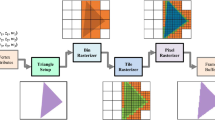Abstract
Achieving an efficient realistic illumination is an important aim of research in computer graphics. In this paper a new parallel global illumination method for hybrid systems based on the hierarchical radiosity method is presented. Our solution allows the exploitation of systems that combine independent nodes with multiple cores per node. Thus, multiple nodes work in parallel in the computation of the global illumination for the same scene. Within each node, all the available computational cores are used through a shared-memory multithreading approach. The good results obtained in terms of speedup on several distributed-memory and shared-memory configurations show the versatility of our hybrid proposal.
Similar content being viewed by others
References
Baiardi F, Mori P, Ricci L (2006) Parallel hierarchical radiosity: The PIT approach. In: Applied parallel computing (LNCS), vol 3732, pp 1031–1040
Caballer M, Guerrero D, Hernández V, Roman JE (2003) A parallel rendering algorithm based on hierarchical radiosity. Lect Notes Comput Sci 2565:523–536
Cohen MF, Wallace JR (1993) Radiosity and realistic image synthesis. Academic Press, San Diego
Dachsbacher C, Stamminger M, Drettakis G, Durand F (2007) Implicit visibility and antiradiance for interactive global illumination. ACM Trans Graph 26(3):61:1–61:10
Hanrahan P, Saltzman D, Aupperle L (1991) A rapid hierarchical radiosity algorithm. In: Proc. SIGGRAPH’91, vol 25, pp 197–206
Hippold J, Rünger G (2003) Task pool teams for implementing irregular algorithms on clusters of SMPs. In: Proc international parallel and distributed processing symposium (IPDPS’03), p 54.2
Kaplanyan A, Dachsbacher C (2010) Cascaded light propagation volumes for real-time indirect illumination. In: I3D ’10: proceedings of the 2010 ACM SIGGRAPH symposium on interactive 3D graphics and games. ACM, New York, pp 99–107. doi:http://doi.acm.org/10.1145/1730804.1730821
Padrón EJ, Amor M, Bóo M, Doallo R (2007) A hierarchical radiosity method with scene distribution. In: Proc. 15th euromicro conf on parallel, distributed and network based processing (PDP 2007), pp 134–138
Padrón EJ, Amor M, Bóo M, Doallo R (2009) High performance global illumination on multi-core architectures. In: Proc of the 17th euromicro conf. on parallel, distributed and network based processing (PDP 2009), pp 93–100
Singh JP, Gupta A, Levoy M (1994) Parallel visualization algorithms: performance and architectural implications. IEEE Comput Graph Appl 27(7):45–55
Author information
Authors and Affiliations
Corresponding author
Rights and permissions
About this article
Cite this article
Padrón, E.J., Amor, M., Bóo, M. et al. Parallel hierarchical radiosity on hybrid platforms. J Supercomput 58, 357–366 (2011). https://doi.org/10.1007/s11227-011-0592-6
Published:
Issue Date:
DOI: https://doi.org/10.1007/s11227-011-0592-6




